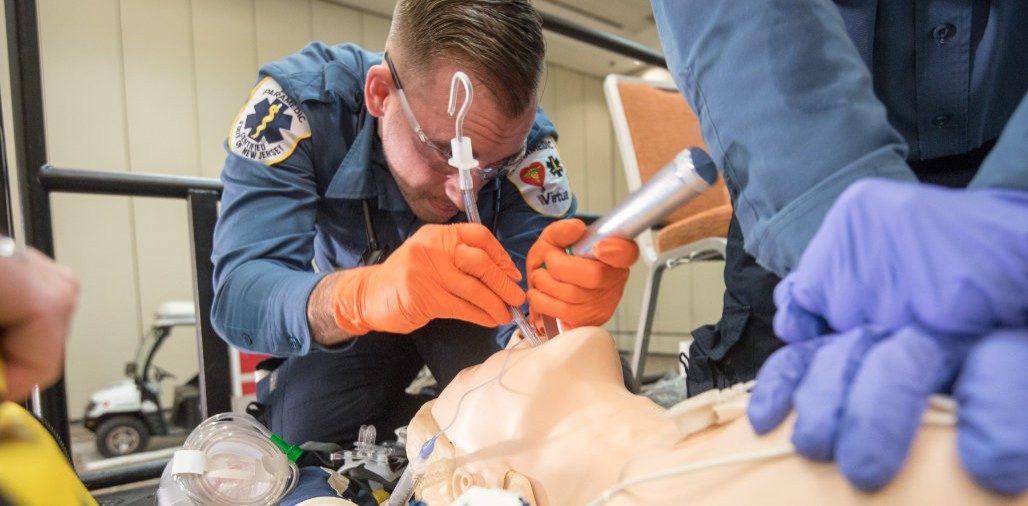 The PART study reveals significant issues regarding paramedic intubation training and skills maintenance. Photos Glen E. Ellman[/caption]
The PART study reveals significant issues regarding paramedic intubation training and skills maintenance. Photos Glen E. Ellman[/caption]
By
On Aug. 30, 2018, the authors of the Pragmatic Airway Resuscitation Trial (PART) published “ETI vs. SGA: The Verdict is In” in JEMS—a review of the findings of their study which compares a supraglottic airway, specifically the King airway, with endotracheal intubation.
Using a clustered, crossover design and engaging 27 agencies in this study, they compared the King airway with standard, direct laryngoscopy intubation. The primary outcome was survival to 72 hours, with secondary outcomes including return of circulation, survival to discharge and survival with good neurologic outcome. They found the King airway to be superior to direct laryngoscopy in both their primary and secondary outcomes.
There was a 3% difference in survival in favor of the King airway, meaning out of every one-hundred resuscitations, three more individuals would survive this time frame. Although the authors didn’t report the adjusted difference, this study suggests that using the King airway would provide an absolute difference of about 2.7% for survival to hospital discharge and about a 2% absolute difference for favorable neurologic outcome.
The authors suggest that the King airway is superior to direct laryngoscopy, and that by using the King airway, an additional 100,000 lives can be saved per year. That’s a pretty good number of lives saved. There are some important caveats to this however.
The first is, how we define success in cardiac arrest resuscitation. The authors chose 72-hour survival as the primary outcome. We would argue that the primary outcome of any cardiac arrest trial should be what everyone who suffers a cardiac arrest would want: discharge with good neurologic outcome. The marker of success should be walking out the doors and returning to the life you had before the cardiac arrest. In this study, for all-comers, that was an abysmal 6%. This is an important number because it tells us that overall, successful resuscitation from cardiac arrest is rare and that a number of our efforts may have some statistically significant differences but the absolute effect on the gold standard outcome is rather small. But that’s a story for another time. The focus here is on airway management in cardiac arrest, and the suggestion that the “verdict is out” on whether or not paramedics should be using an endotracheal tube or a supraglottic device.
To say the verdict is out based on this one study is a bit premature, if not irresponsible. It is akin to moving to sentencing right after the opening remarks from the prosecution. The research has been looking at this problem for about a decade and the answer is still unclear.
One of the largest cohorts is derived from a 2015 meta-analysis, which included around 75,000 patients. This analysis found that standard endotracheal intubation (SETI) was superior to supraglottic airway (SGA) devices.1
A secondary analysis of the oft cited PRIMED study also reported that SETI was superior to SGI, with Dr. Henry E. Wang, the lead author of the PART study, as the lead author for that study as well.2
These are just two of the many papers that compare SETI with SGA, and the results have been varied. Regardless of study design, outcomes, the devices used or the authors performing the studies, the results of these works reveal something more than which technique or device is better. What it reveals is there are significant issues regarding paramedic training and skills maintenance.
Intubation Skill Maintenance
The question these or any authors should be asking is not should we be spending research dollars on whether or not one device or other results in a 2–3% difference in an already abysmal outcome. That may not have any value with regard to any actual meaningful clinical outcome. What the EMS community should be asking is why are intubation success rates so low?
In the study by Wang et al, they demonstrated a 56% first pass success rate and that multiple attempts occurred 18% of the time. This is rather concerning. Although the intubating environment in the prehospital setting can be austere, that alone doesn’t account for why paramedics had such difficulty with this skill. What the PART trial may be demonstrating is that hypoxia should be avoided during resuscitation and periods of hypoxia are bad. We don’t know for sure because this wasn’t part of the study.
What we don’t think you can draw from this or any study published to date is that intubation is bad. If that were true, we wouldn’t be doing it in the ED or in the ICU. Endotracheal intubation is the gold standard in these settings. The question we should be trying to answer is “how do we make paramedics better at intubating?”
The answer isn’t as hard as we think. It comes down to just a few things.
The first is training. Paramedic training has continued to take a backwards slide from an associate degree to online programs that can be completed in a little over a year. That’s the opposite of what other professions have done and it’s degrading the quality of paramedicine.
The second issue is oversight and skills maintenance. It’s our position that EMS physicians and their colleagues need to better support EMS systems. There need to be standards with regard to skills maintenance that includes spending time in the ED and operating rooms to maintain a variety of low-volume skills including intubation. Skills maintenance also comes from performing skills in the field. In systems saturated with paramedics, especially for low-volume systems, the opportunity to perform important skills is inadequate for skills maintenance. The concept of regional paramedic systems is one important solution to that issue. Engineering solutions are also needed, integrating fiberoptic technology and video laryngoscopy for difficult field intubations.
EMS research needs to change as well. There needs to be a focus on how we can make things better, be it improving bystander CPR, increased access to AEDs or means to reduce interruptions in chest compressions. These are all proven to make the most important differences in survival from cardiac arrest, and this is where there should be the most focus.
Conclusion
The PART study’s aim was to demonstrate that SGA is superior to SETI. Whether this is true or not remains to be seen. That doesn’t mean this study doesn’t have value. It clearly demonstrated that an important, time-honored and gold standard skill in resuscitation isn’t being practiced effectively by paramedics. The solution should not be to abandon the procedure. The solution is that we need to fix the problem. We need to enhance education, provide more opportunity for skills maintenance and develop systems that ensure that paramedics are regularly practicing these advanced skills. It is time for the EMS community to step up and improve the system and to continue to work towards success and professionalism.
References
1. Benoit JL, Gerecht RB, Steuerwald MT, et al. Endotracheal intubation versus supraglottic airway placement in out-of-hospital cardiac arrest: A meta-analysis. Resuscitation. 2015;93:20–26.
2. Wang HE, Szydlo, D, Stouffer J, et al. Endotracheal intubation versus supraglottic airway insertion in out-of-hospital cardiac arrest. Resuscitation. 2012;83(9):1061–1066.
By

 Stephen P. Wood, MS, ACNP-BC
Stephen P. Wood, MS, ACNP-BC Benjamin Podsiadlo, EMT-P
Benjamin Podsiadlo, EMT-P
Recent Comments